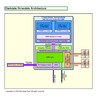Intel Core 2 Duo T6400 vs Intel Core i5-520UM vs Intel Core 2 Duo SL9600
Intel Core 2 Duo T6400
► remove from comparisonDer Intel Core 2 Duo T6400 ist ein Einstiegsprozessor für Notebooks. Er basiert auf den Penryn Kern, bietet jedoch nur 2 MB Level 2 Cache und ist mit 2 GHz relativ langsam getaktet.
Durch die mittelmäßige Taktfrequenz und den kleinen Level 2 Cache, kann die CPU bei modernen und anspruchsvollen Spielen durchaus limitieren (z.B. große Multiplayerschlachten bei Supreme Commander). Für die mittelmäßig anspruchsvolle (nicht professionelle) Anwendungen wie Office, Entry-Level Videoschnitt, Bildbearbeitung, Internet und casual Gaming sollte die Leistung jedoch ausreichen.
Der Penryn (Montevina Update) Kern bietet 2 Integer Units, 1 Floating Point Unit, 1 Load Unit und 1 Store Unit in einer 14-stufigen Pipeline. Mit der Wide Dynamic Execution Technologie kann der Kern bis zu vier volle Instruktionen gleichzeitig ausführen.
Das integrierte Enhanced Speedstep kann die Taktfrequenz des Prozessors dynamisch an die Leistungsanforderungen anpassen. Dadurch läuft die CPU ohne Last nur mit 800 MHz.
Intel Core i5-520UM
► remove from comparison
Der Intel Core i5-520UM ist ein zwei-Kern Prozessor für sehr kleine und leichte Notebooks und taktet dank Turbo mit 1.06 - 1.86 GHz. Das U im Namen steht für Ultra Low Voltage und bezeichnet den geringen Stromverbrauch der CPU (sie wird mit einer geringen Spannung betrieben). Die zwei Kerne basiert auf die Nehalem (Westmere) Mikro-Architektur und können dank Hyperthreading 4 Threads gleichzeitig abarbeiten. Der langsamere Turbo und der geringer L3 Cache sind der Unterschied zum i7-620UM.
Eine Besonderheit der neuen Dual-Core CPUs von Intel ist die Integration des Speichercontrollers und einer integrierten Grafikkarte (GMA HD) in das Package. Die CPU wird bereits in 32nm hergestellt, der Die für den Speichercontroller und die Grafikkarte jedoch noch in 45nm.
Im Vergleich zu den anderen Dual Core Core i5 CPUs, bieten die U Modelle nur Anschluss für DDR3 800.
Erster Performance Test des Desktop Core i3 530 (2.93 GHz ohne Turbo) bescheinigt eine teilweise spürbar bessere Performance der neuen Architektur im Vergleich zu einem Core 2 Duo E8400 (3.0 GHz) [pconline.com.cn]. Dadurch sollte der Core i5-520UM im Schnitt schneller als ein Core 2 Duo SU9400 (1.4 GHz) sein. Je nachdem wie gut das Kühlungssystem des Subnotebooks ist, kann auch der Turbo oft greifen und dadurch die Geschwindigkeit noch deutlich erhöhen.
Die 32-nm-Prozessorkerne der Westmere-Generation verarbeiten auch einige neue Befehle, die AES-Verschlüsselung beschleunigen sollen.
Die integrierte Intel Graphics Media Accelerator HD (GMA HD) Grafikkarte wird mit 133-500 MHz getaktet werden (dank Turbo Boost) und schneller sein als die alte GMA 4500MHD.
Der Stromverbrauch ist mit einem TDP von 17 Watt zwar relativ hoch für einen ULV Prozessor, jedoch ist darin die integrierte Grafikkarte und auch der Speichercontroller enthalten (vormals im Chipsatz welcher selbst 12 Watt benötigte). Dadurch ist der Stromverbrauch des ganzen Systems relativ gering. Durch den Turbo Mode wird der TDP unter Last jedoch (öfter) ausgereizt, wodurch der Stromverbrauch höher ausfallen kann als bei ähnlich spezifizierten Core 2 Duo Modellen.
Intel Core 2 Duo SL9600
► remove from comparisonDer Intel Core 2 Duo SL9600 ist ein stromsparender Prozessor für kleine und flache Notebooks. Er basiert auf den Penryn Kern und bietet die gesamten 6 MB Level 2 Cache. Dadurch ist die Performance deutlich besser, als bei anderen 2.1 GHz Core 2 Duo Modellen. Mit 17 Watt TDP eignet sich die CPU auch für flache Notebooks. Verbaut wurde der SL9600 z.B. im Apple MacBook Air, wobei hier jedoch durch häufiges Throtteln die Performance niedriger ist (daher stammen auch die schwächeren Benchmarks in unserer Datenbank).
Der C2D SL9600 bietet alle Features des Penryn Kerns wie Virtualisierung VT-x oder Trusted Execution.
Im Unterschied zu anderen Core 2 Duo Modellen, unterstützt der SL9600 nur den Socket BGA956.
| Model | Intel Core 2 Duo T6400 | Intel Core i5-520UM | Intel Core 2 Duo SL9600 | ||||||||||||||||||||||||||||||||||||||||||||||||||||
| Series | Intel Core 2 Duo | Intel Core i5 | Intel Core 2 Duo | ||||||||||||||||||||||||||||||||||||||||||||||||||||
| Codename | Penryn | Arrandale | Penryn | ||||||||||||||||||||||||||||||||||||||||||||||||||||
| Serie: Core 2 Duo Penryn |
| ||||||||||||||||||||||||||||||||||||||||||||||||||||||
| Clock | 2000 MHz | 1060 - 1866 MHz | 2130 MHz | ||||||||||||||||||||||||||||||||||||||||||||||||||||
| FSB | 800 | 2500 | 1066 | ||||||||||||||||||||||||||||||||||||||||||||||||||||
| L2 Cache | 2 MB | 512 KB | 6 MB | ||||||||||||||||||||||||||||||||||||||||||||||||||||
| Cores / Threads | 2 / 2 | 2 / 4 | 2 / 2 | ||||||||||||||||||||||||||||||||||||||||||||||||||||
| TDP | 35 Watt | 18 Watt | 17 Watt | ||||||||||||||||||||||||||||||||||||||||||||||||||||
| Technology | 45 nm | 32 nm | 45 nm | ||||||||||||||||||||||||||||||||||||||||||||||||||||
| max. Temp. | 105 °C | 105 °C | 105 °C | ||||||||||||||||||||||||||||||||||||||||||||||||||||
| Socket | PGA478 | BGA1288 | BGA956 | ||||||||||||||||||||||||||||||||||||||||||||||||||||
| Features | MMX, SSE, SSE2, SSE3, SSSE3, SSE4.1, Enhanced Intel SpeedStep Technology (EIST), Intel 64, XD bit (an NX bit implementation), IDA (Intel Dynamic Acceleration) | Turbo Boost (1.86 GHz max), Hyper Threading, Enhanced Speedstep, integrierte GMA HD 166-500MHz, | Enhanced Speedstep, Intel VT, TXT, Intel64 | ||||||||||||||||||||||||||||||||||||||||||||||||||||
| Architecture | x86 | x86 | x86 | ||||||||||||||||||||||||||||||||||||||||||||||||||||
| Announced | |||||||||||||||||||||||||||||||||||||||||||||||||||||||
| Manufacturer | ark.intel.com | ark.intel.com | ark.intel.com | ||||||||||||||||||||||||||||||||||||||||||||||||||||
| L3 Cache | 3 MB | ||||||||||||||||||||||||||||||||||||||||||||||||||||||
| Transistors | 382+177 Million | 410 Million | |||||||||||||||||||||||||||||||||||||||||||||||||||||
| Die Size | 81+114 mm2 | 107 mm2 | |||||||||||||||||||||||||||||||||||||||||||||||||||||
| $241 U.S. | $316 U.S. | ||||||||||||||||||||||||||||||||||||||||||||||||||||||
| L1 Cache | 128 KB | ||||||||||||||||||||||||||||||||||||||||||||||||||||||
| Voltage | 1.05-1.15 V |


 Deutsch
Deutsch English
English Español
Español Français
Français Italiano
Italiano Nederlands
Nederlands Polski
Polski Português
Português Русский
Русский Türkçe
Türkçe Svenska
Svenska Chinese
Chinese Magyar
Magyar